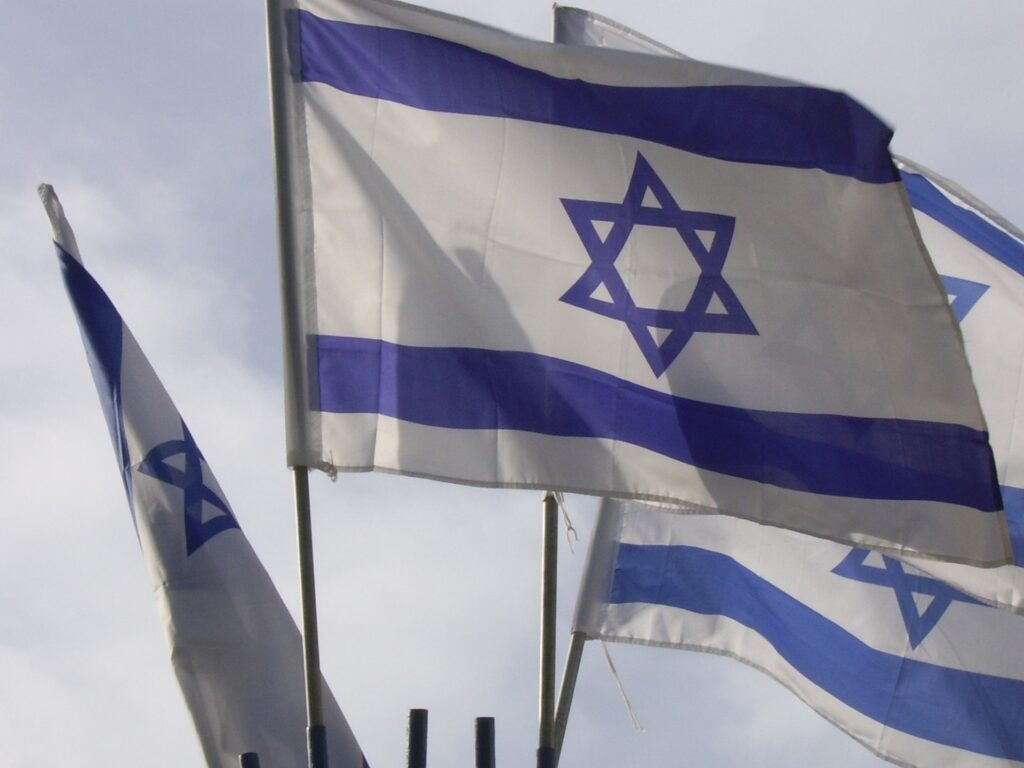The Israeli flag and national anthem, the Hatikvah, are two of the most important symbols of the modern state of Israel. The flag, with its blue and white stripes and six-pointed Star of David, is instantly recognizable around the world, and serves as a powerful reminder of the country’s Jewish heritage and identity. The Hatikvah, with its haunting melody and poignant lyrics, reflects the deep sense of hope and determination that has sustained the Jewish people throughout their long and often difficult history.
Together, the Israeli flag and Hatikvah represent the resilience and strength of the Jewish people, as well as their enduring commitment to building a homeland that is safe, prosperous, and free.
In this article, we will explore the history and meaning of these two iconic symbols and the important role they continue to play in shaping Israeli identity and culture.
The Flag of Israel
The Israeli flag was designed by a committee led by the first Israeli Prime Minister, David Ben-Gurion, shortly after the establishment of the State of Israel in 1948. The committee included notable individuals such as Zvi Herman Berkowitz, who was a graphic designer and artist, and Gavriel Holtzberg, who was an engineer and artist. The design of the flag was influenced by the blue and white colors of the Zionist movement’s flag, which had been used as the official emblem of the movement since 1891.
It’s noteworthy that previously it was suggested that the flag would have not one but seven Magen David stars!
The flag of Israel is a symbol of the state and its people. It was first introduced on October 28, 1948, five months after the establishment of the State of Israel. The flag is made up of two blue stripes on a white background, with a Star of David in the center.

The origins of the design of the Israeli flag can be traced back to the Zionist movement, which aimed to create a Jewish homeland in the Holy Land. The movement adopted a blue and white flag as its official emblem, which was inspired by the tallit, a Jewish prayer shawl worn during religious ceremonies.
The blue stripes on the flag were added to represent the stripes on the tallit, while the white background was meant to symbolize purity, innocence, and peace. The Star of David, which has been a symbol of Jewish identity for centuries, was chosen as a central emblem to represent the Jewish people.
The flag was initially controversial, as some members of the Knesset felt that it should include the symbol of the Menorah, a seven-branched candelabrum that is a symbol of the Jewish people.
However, Ben-Gurion argued that the Star of David was a more inclusive symbol, as it represented Jews from all over the world, including those who did not identify with the Menorah. In the end, Ben-Gurion’s argument won out, and the Star of David was included as the central emblem on the flag.
The Israeli flag has since become a symbol of Jewish pride and identity, and it is flown on many occasions, including national holidays, military ceremonies, and sporting events. It is also frequently used in protests and demonstrations, both within Israel and around the world, to represent the Jewish people and their struggle for self-determination.
Today, the Israeli flag remains an important symbol of the Jewish people and their history. Its design reflects the hopes and aspirations of the Zionist movement, and its adoption as the national flag of Israel marked a significant milestone in the long struggle for the creation of a Jewish State.
The HaTikvah Hymn
In addition to the flag, the Hatikvah Hymn has played important roles in the history and culture of Israel.
The Hatikvah, which means “The Hope” in Hebrew, is a powerful expression of the Jewish longing for a homeland and self-determination. The anthem’s lyrics speak of the Jewish people’s 2,000-year history of exile and persecution, and their yearning to return to their ancestral land. The final lines of the song express the hope that the Jewish people will one day be able to live in freedom and dignity in their own country:
“Od lo avdah tikvatenu
Hatikvah bat shnot alpayim
Lihyot am chofshi be’artzenu
Eretz Tzion v’Yerushalayim”
Translated to English, these lines read:
“Our hope is not yet lost,
The hope of two thousand years,
To be a free people in our land,
The land of Zion and Jerusalem.”

The Hatikvah has become an integral part of Israeli culture and identity and is often sung at public events and ceremonies, including Independence Day celebrations, military parades, and sporting events. It is also commonly played at Jewish weddings, funerals, and other religious and cultural events.
However, we couldn’t finish this article without mentioning a lesser-known symbol, which is…
The Star of David
The Star of David, also known as the Shield of David or Magen David in Hebrew, is a six-pointed star that has become an important symbol of Jewish identity and heritage. The exact origins of the Star of David are unclear, and it has been used by Jews in different ways and contexts throughout history.
The earliest known use of the Star of David as a Jewish symbol can be traced back to a Jewish cemetery in Taranto, Italy, where it appeared on a tombstone dating back to the 3rd or 4th century CE. This tombstone was discovered in the 19th century and is now on display at the Jewish Museum of Rome.
The existence of the Taranto tombstone was first documented by the German-Jewish scholar Gustav Dalman in the early 20th century, and later confirmed by other historians and archeologists. The tombstone features a six-pointed star engraved above the Hebrew inscription, which reads, “The one buried here is Shim’on, son of Yochanan, a priest, who made the palace for the children of Israel in Taranto, and who died in peace.”
The book Ta’amei HaMitzvot (טעמי המצוות) of the Rav Shabtai Cohen (the Shach), writes that when the Jewish soldiers went to war in times of Dovid Hamelech, they etched a symbol of a triangle on their shields to remind them not to trust in their own might (כחי ועוצם ידי) but rather they will win only because Israel, the Torah and Hashem are one (ישראל ,אורייתא,וקודשה בריך הוא חד הוא)
Later on, many other holy things (דברי קדושה) started using this symbol to show that they are intertwined and can’t be separated and so, the double intertwined triangle was introduced.
These discoveries provide important evidence of the early use of the Star of David as a Jewish symbol, and suggest that it was already in use among Jewish communities in Italy during the early centuries of the Common Era.
Some scholars have suggested that the six-pointed star may have been derived from similar geometric patterns used in Islamic and Christian art, which were also popular in the Middle East during this time. Others have suggested that the Star of David may have been adopted by Jews as a symbol of protection, or as a way to differentiate themselves from other religious and cultural groups.
During the medieval period, the Star of David began to appear more frequently in Jewish art and religious texts, such as the Kabbalistic Zohar, where it was associated with mystical and esoteric teachings. The star was also used as a decorative motif on Jewish ceremonial objects, such as Torah covers and prayer books.
The use of the Star of David as a symbol of Jewish identity increased during the modern era, particularly during the 19th and 20th centuries, when Jewish communities in Europe and the Middle East faced increasing persecution and discrimination. The symbol was incorporated into the official emblem of the Zionist movement in the late 1800s, and it became a prominent feature of the Israeli flag when the state of Israel was established in 1948.
Today, the Star of David is recognized as a symbol of Jewish identity and heritage by Jews around the world, and it is often used in Jewish art, jewelry, and other cultural expressions. Even the shipping company Zim uses 7 Magen David stars in their logo, as a form of patriotism to the first suggestion of the flag.
While its exact origins remain shrouded in mystery, the Star of David has become a powerful and enduring symbol of Jewish history, culture, and faith.

Concluding Remarks
In conclusion, the Israeli flag, HaTikvah anthem, and Star of David are three iconic symbols that represent the deep history and culture of the Jewish people. The flag’s blue and white stripes and Star of David serve as a powerful visual reminder of Israel’s Jewish heritage, while the HaTikvah anthem reflects the deep sense of hope and determination that has sustained the Jewish people throughout their long and often difficult history. The Star of David, with its origins shrouded in mystery, has become an enduring symbol of Jewish identity and faith, and a reminder of the resilience and strength of the Jewish people.
Together, these symbols have played an important role in shaping Israeli identity and culture, and continue to serve as powerful symbols of Jewish heritage and pride around the world. They represent the deep connection between the Jewish people and the land of Israel, and the determination of the Jewish people to build a homeland that is safe, prosperous, and free.
As we continue to explore the history and meaning of these symbols, we are reminded of the important role they continue to play in the lives of Jews around the world, and the ongoing struggle for freedom, justice, and peace that has defined Jewish history for thousands of years. May we always remember the powerful legacy of these symbols, and the enduring spirit of hope and determination they represent.




